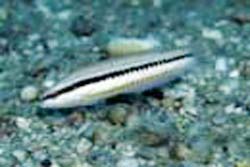An (ecological) origin of species for tropical reef fish

Dealing a new blow to the dominant evolutionary paradigm, Luiz Rocha and colleagues from the Smithsonian Tropical Research Institute, Harvard University the University of Florida and the University of Hawaii, report coral reef fish from neighboring habitats may differ more from one another than from fish thousands of miles away. An ecological speciation model for coral reef organisms may spur the development of a more synthetic treatment of speciation on land and sea.
Coral reefs, like tropical forests, express an extreme of life’s capacity for variation. Yet high biodiversity in tropical seas foil evolutionists’ attempts to explain the splitting of one species into two on the basis of geographical barriers. According to standard evolutionary theory proposed by Dobzhansky and Mayr more than 50 years ago, mountain building, island formation, glaciation and other processes isolate populations within a species. Over evolutionary time, these populations mutate independently until individuals from distinct populations can no longer interbreed and become new species.
What explains the evolution of a huge number of closely related fish species on reefs in an open undersea world where currents constantly stir the waters, washing in fish or their larvae from afar, a world without well-defined geographical barriers? Rocha et al. took a close look at the genetics of one group of Western Atlantic tropical reef fishes (wrasses, genus Halichoeres) throughout their range and were surprised by what they found.
Rocha explains: “I was interested in the Amazon barrier. The Amazon and Orinoco’s freshwater and sediment discharge off of northeastern South America is so immense that it precludes coral reef formation from the mouth of the Amazon North to Trinidad and Tabago. This 2000 km gap is believed to be a strong barrier for corals and associated reef organisms.”
“My idea was to test whether or not wrasses in the genus Halichoeres were genetically different North and South of this barrier. Since all of these species have similar abilities to disperse, I expected to find genetic differences that corresponded to the barrier in all of them, but, surprisingly, that wasn’t the case.”
Mitochondrial DNA of adult fish and larvae from three locations in the Caribbean and from three locations in Brazil showed much clearer genetic differences within, rather than across, the two sides of the Amazon barrier. Genetically similar fish were found in ecologically similar habitats–even thousands of miles apart.
Wrasses collected only 360 km apart along the Brazilian coast were genetically more distinct than were fish collected 4200 km apart, from Fernando de Noronha island off of the Brazilian coast and St. Croix in the Caribbean.
The fact that evolutionary partitions correspond more closely to habitat type, rather than to conventional geographical barriers, indicates that local speciation events may overcome the homogenizing effect of migration in the ocean, vindicating Darwin’s original ideas about the importance of ecological speciation in biodiversity evolution.
Media Contact
All latest news from the category: Ecology, The Environment and Conservation
This complex theme deals primarily with interactions between organisms and the environmental factors that impact them, but to a greater extent between individual inanimate environmental factors.
innovations-report offers informative reports and articles on topics such as climate protection, landscape conservation, ecological systems, wildlife and nature parks and ecosystem efficiency and balance.
Newest articles

Bringing bio-inspired robots to life
Nebraska researcher Eric Markvicka gets NSF CAREER Award to pursue manufacture of novel materials for soft robotics and stretchable electronics. Engineers are increasingly eager to develop robots that mimic the…

Bella moths use poison to attract mates
Scientists are closer to finding out how. Pyrrolizidine alkaloids are as bitter and toxic as they are hard to pronounce. They’re produced by several different types of plants and are…

AI tool creates ‘synthetic’ images of cells
…for enhanced microscopy analysis. Observing individual cells through microscopes can reveal a range of important cell biological phenomena that frequently play a role in human diseases, but the process of…





















